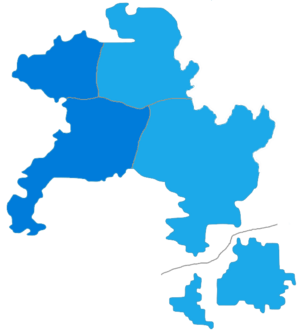Akashian general election, 2006
| |||||||||||||||||||||||||||||||||||||||||||||||||||||||||||||||||||||||||||||||||||||
400 seats in the National Assembly 201 seats needed for a majority | |||||||||||||||||||||||||||||||||||||||||||||||||||||||||||||||||||||||||||||||||||||
|---|---|---|---|---|---|---|---|---|---|---|---|---|---|---|---|---|---|---|---|---|---|---|---|---|---|---|---|---|---|---|---|---|---|---|---|---|---|---|---|---|---|---|---|---|---|---|---|---|---|---|---|---|---|---|---|---|---|---|---|---|---|---|---|---|---|---|---|---|---|---|---|---|---|---|---|---|---|---|---|---|---|---|---|---|---|
| Turnout | 83,7% | ||||||||||||||||||||||||||||||||||||||||||||||||||||||||||||||||||||||||||||||||||||
| |||||||||||||||||||||||||||||||||||||||||||||||||||||||||||||||||||||||||||||||||||||
 Most voted party by province | |||||||||||||||||||||||||||||||||||||||||||||||||||||||||||||||||||||||||||||||||||||
| |||||||||||||||||||||||||||||||||||||||||||||||||||||||||||||||||||||||||||||||||||||
A general election was held in Akashi on 24 June 2006. The Anna Carbone government was re-elected in a landslide, and the election was the second to be nicknamed a "blue wave" (Miranian: 青い波 aoi nami) after 1986.
Anna Carbone had won broad popularity for her stable governance, presiding over steady economic growth, progressive social policies, and an expansion of cooperatives and the public sector. Her government was seen as a favourite for re-election, but several factors converged to produce the "blue wave".
The Socialist Party under Momoru Matsuda tried to moderate its image and move towards social democracy. This incensed the party base and dampened turnout among supporters. Finance minister Liana Ferrari, who had spent the last decade making the United Reform Party a conservative socialist party, seized on the SP disunity and turmoil.
Already famous for her flamboyant public profile and boisterous image, Liana ran an energetic and populist campaign, seeking to outflank the SP from the left. She promised great increases in public spending and a strengthened competition law that would crack down on big business and expand the cooperative sector. One of her famous campaign stunts was to print posters showing herself naked and pregnant, with the caption, "A great government is about to be born."
One of the few opposition politicians who managed to resist Liana's attention-grabbing campaign tactics was Communist Party leader Rise Takashima. The former health minister in the Shinobu Furukawa government, Rise was favoured by a blunt-spoken image similar to Shinobu, and energised the party campaign, despite privately expressing frustration that much of it was spent on the defensive.
Results
| General election, 24 June 2006 | |||||||||
|---|---|---|---|---|---|---|---|---|---|

| |||||||||
| Party | Party list | Constituency | Total seats |
+/- | |||||
| PR | % | +/− | STV | % | +/− | ||||
| Moderate People's Party | 1.823.342 | 27,1% | +7,0% | 1.733.802 | 25,8% | +4,3% | 122 | +21 | |
| United Reform Party | 1.809.886 | 26,9% | +15,9% | 1.706.921 | 25,4% | +13,2% | 121 | +77 | |
| Communist Party | 834.297 | 12,4% | +2,2% | 739.218 | 11,0% | +0,4% | 48 | +6 | |
| Socialist Party | 518.071 | 7,7% | -8,5% | 557.773 | 8,3% | -5,2% | 32 | -44 | |
| Green Party | 437.333 | 6,5% | -3,0% | 537.613 | 8,0% | -0,4% | 26 | -8 | |
| Future Party | 417.148 | 6,2% | -4,2% | 524.173 | 7,8% | -2,5% | 20 | -13 | |
| National Cooperative Party | 376.779 | 5,6% | -4,2% | 416.650 | 6,2% | -3,4% | 21 | -16 | |
| National Union | 148.020 | 2,2% | -2,5% | 168.004 | 2,5% | -2,5% | 5 | -10 | |
| Conservative National Party | 127.836 | 1,9% | -0,4% | 100.802 | 1,5% | -1,3% | 0 | -6 | |
| Akashi Renewal Party | 121.108 | 1,8% | -0,3% | 107.523 | 1,6% | -1,1% | 0 | -5 | |
| Independents | 114.379 | 1,7% | -1,3% | 127.683 | 1,9% | -1,5% | 5 | -5 | |
| Total | 6.728.200 | 100% | — | 6.720.162 | 100% | — | 400 | — | |
| Registered voters and turnout | 8.038.471 | 83,7% | — | 8.038.471 | 83,6% | ||||
| Bloc strength | ||
|---|---|---|
| Bloc | Parties | Seats |
| Crimson bloc | CP, GP | 74 |
| Pale crimson bloc | SP, NU | 37 |
| Light yellow bloc | NCP, FP | 41 |
| Light blue bloc | MPP, URP | 243 |
| Dark blue bloc | CNP, ARP | 0 |
- Government: Moderate People's Party–United Reform Party coalition.
The MPP and URP gained a landslide victory together: they won 54% of the PR vote and 51,2% of first preferences, and had a comfortable majority of 42 seats. Liana succeeded in winning over centre-left voters frustrated with the SP's poor leadership, propelling the URP to a second-place finish.
The centre-right swept all provinces: the URP managed to overtake the left in Kobi and Shimachi, and surpassed the MPP in Matō. The latter result was somewhat surprising to analysts, but reflected Liana's prominence in the campaign and the way she overshadowed the lower-key Anna.
The election was an unequivocal disaster for the pale crimson bloc. The SP lost 44 seats and fell to fourth place, a more humiliating result than 1986 since now they weren't even the largest opposition party. Despite the frustration of losing their stronghold of Kobi, the CP held steady and won 6 more seats, making Rise the leader of the opposition.
One of the few developments welcomed across the spectrum was the dark blue bloc being once again shut out of the legislature. The CNP and ARP lost the constituency seats that had qualified them for party list seats, and their PR vote fell further from the 3% election threshold.
Anna's coalition easily continued in office, no longer needing support from the light yellow bloc or independents. Kyō! would later describe this term as "Liana's hubris": despite her success as finance minister, the public grew tired of her positioning herself as a future Prime Minister, including a quixotic campaign to merge the SP with the URP. By the next election, her "heir apparent" status and belief in a "permanent centre-right majority" (inspired by Róisín Ní Bradáin) backfired.




